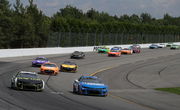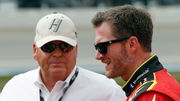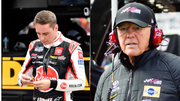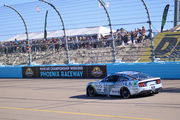
via Imago
US PRESSWIRE Sports Archive Feb 17, 1985 Daytona Bch, FL, USA FILE PHOTO NASCAR, Motorsport, USA Winston Cup driver Richard Petty during the Daytona 500 at the Daytona International Speedway. Daytona Beach Florida UNITED STATES, EDITORIAL USE ONLY PUBLICATIONxINxGERxSUIxAUTxONLY Copyright: xMannyxRubio-USAxTODAYxSportsx 3936073

via Imago
US PRESSWIRE Sports Archive Feb 17, 1985 Daytona Bch, FL, USA FILE PHOTO NASCAR, Motorsport, USA Winston Cup driver Richard Petty during the Daytona 500 at the Daytona International Speedway. Daytona Beach Florida UNITED STATES, EDITORIAL USE ONLY PUBLICATIONxINxGERxSUIxAUTxONLY Copyright: xMannyxRubio-USAxTODAYxSportsx 3936073
In smoky garages and grandstands across America, NASCAR fans have been waging the same debate for decades: Which track style reigns supreme? The high-banked thunder of superspeedways? The bumping and grinding of short tracks? Or perhaps the technical challenge of road courses? Just when you think the argument might finally burn out of fuel, The King himself—Richard Petty—rolls up with an answer that leaves the debate in his rearview mirror.
When you’ve collected 200 checkered flags and seven Cup Series Championships, people tend to listen. The setting was casual, but the question carried weight. So, when a fan recently posed the eternal question about the King’s preferred racing surface during a video for the Petty Family Racing YouTube channel, racing enthusiasts leaned in for what they assumed would be the definitive word on the matter.
ADVERTISEMENT
Article continues below this ad
Richard Petty just loves racing
“All of the above and everything in between,” Richard Petty responded without hesitation. “From my standpoint, you know, you could have went out here in the parking lot and put up some barrels and stuff and said, you know, race around here. It would have been fine with me. So it didn’t make no difference where it was. Dirt, big track, little track. I just loved to drive a race car.”
The simplicity of the answer speaks volumes about the man who dominated every conceivable configuration NASCAR could offer. The record books back up his claim. Richard Petty conquered the half-mile dirt oval at North Wilkesboro just as decisively as the 2.5-mile asphalt behemoth at Daytona. His record 15 victories on Martinsville’s tight paperclip sits alongside his unprecedented seven Daytona 500 triumphs. In 1967 alone, during his second championship season, Petty won on 10 different tracks ranging from quarter-mile dirt bullrings to massive superspeedways, often in the same Plymouth that his father and crew chief, Maurice, had meticulously prepared for any challenge.
Richard Petty’s dominance across tracks was especially prevalent during the six years between 1967 and 1972. He amassed an astonishing 100 victories across this period, picking up three championships in the process. He did it all with a smile on his face and the determination to dominate anywhere he drove. This is what made Petty a class apart.
View this post on Instagram
What separates the legends from the merely great in motorsports often isn’t just raw talent but a particular mindset—one that Petty’s answer perfectly captures. It wasn’t about the track; it was about the race itself, the pure joy of competition behind the wheel. This was never more evident than at Ontario Motor Speedway in 1972, when Petty’s engine blew early, but he still stayed until the end, telling reporters simply that he needed to be on race tracks, even when he was not racing.
What’s your perspective on:
Is Petty's 'anywhere, anytime' racing philosophy the secret to his unmatched NASCAR success?
Have an interesting take?
Trending
ADVERTISEMENT
Article continues below this ad
The racing philosophy that built a dynasty
This “anywhere, anytime” approach didn’t just define Petty’s career—it helped build NASCAR itself. During the pivotal 1971 season, when R.J. Reynolds Tobacco entered the sport with Winston sponsorship, Petty’s willingness to race at small local tracks kept the grassroots connection alive. While some drivers baulked at facilities lacking modern amenities, Petty’s #43 STP Dodge would reliably appear at places like Bowman Gray Stadium—a quarter-mile track wrapped around a football field—drawing crowds that sustained NASCAR through its critical growth period.
His versatility proved crucial during the 1973 season when NASCAR’s schedule featured a wildly diverse 28 tracks. While competitors struggled with the constant adjustments between surfaces and configurations, Petty amassed 13 wins across 11 different tracks on his way to another championship. This adaptability was further demonstrated in 1986 at the end of his career when, at 49 years old, he managed a surprising second-place finish at Sonoma’s road course—a discipline American oval racers typically struggled with.
For Richard Petty, the debate over which track is best was always beside the point. As his simple yet profound answer reminds us, sometimes the most ‘King-like’ perspective isn’t choosing sides in racing’s endless debates—it’s transcending them altogether with a love for the fundamental act that built the sport: climbing into a race car and driving it as fast as possible, no matter where the race happens to be.
ADVERTISEMENT
Article continues below this ad
ADVERTISEMENT
ADVERTISEMENT
ADVERTISEMENT
ADVERTISEMENT







Is Petty's 'anywhere, anytime' racing philosophy the secret to his unmatched NASCAR success?